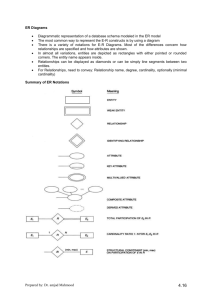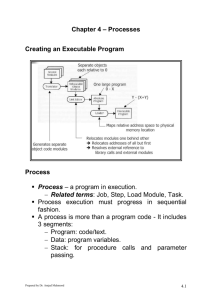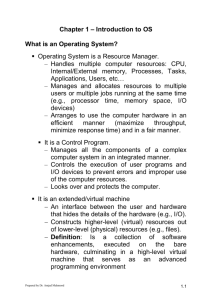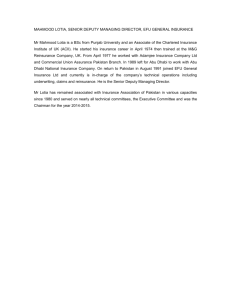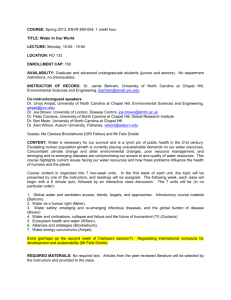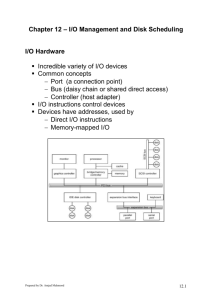Chapter 8: Memory Management
advertisement
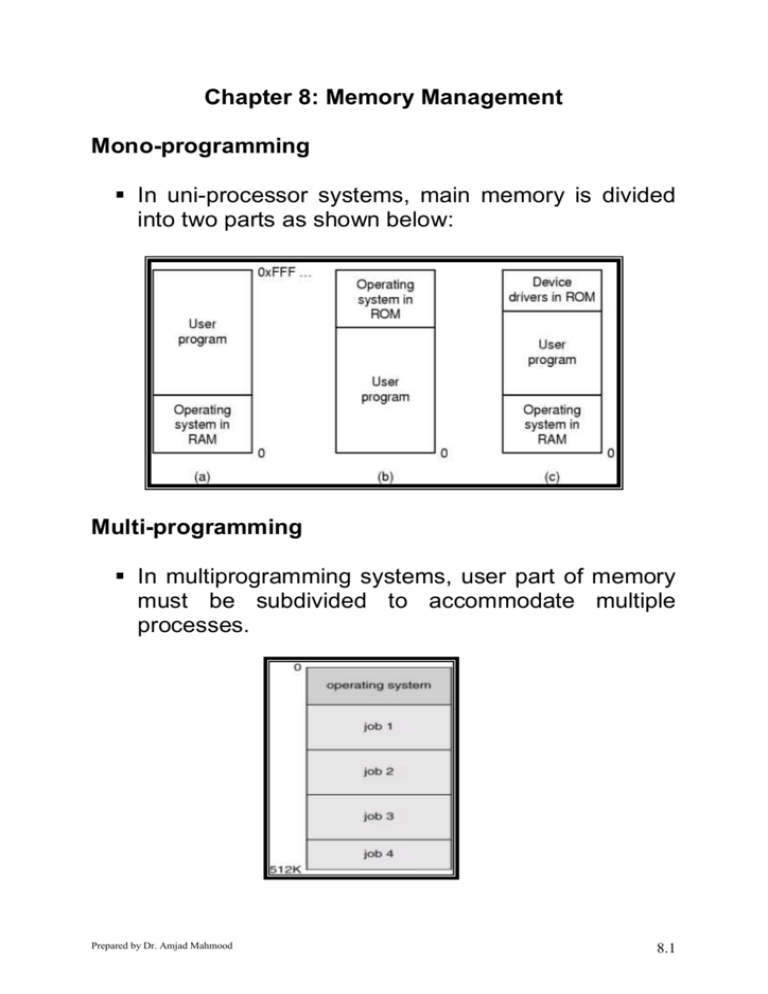
Chapter 8: Memory Management Mono-programming In uni-processor systems, main memory is divided into two parts as shown below: Multi-programming In multiprogramming systems, user part of memory must be subdivided to accommodate multiple processes. Prepared by Dr. Amjad Mahmood 8.1 Memory Management Main memory is a resource that must be allocated and deallocated Memory Management Techniques determine: How the memory is to be (logically) subdivided? Where and how a process resides in memory? How addressing is performed? How process can be relocated? How memory is to be protection? How memory can be shared by processes? How to logical and physically organize memory Addressing Requirements of a Process Prepared by Dr. Amjad Mahmood 8.2 The Basics Program must be brought into memory and placed within a process for it to be run. Input queue – collection of processes on the disk that are waiting to be brought into memory to run the program. Normally, a process is selected from the input queue and is brought into the memory for execution. During execution of a process, it accesses instruction and data from the memory. Most systems allow a user process to be loaded in any part of the memory. This affects the addresses that a user program can access. User programs go through several steps before being run. Addresses may be represented during these steps. Addresses in the source program are generally symbolic (variable name). Prepared by Dr. Amjad Mahmood 8.3 A compiler typically binds these addresses to relocatable addresses (in terms of offsets). The linkage editor or loader binds relocatable addresses to absolute addresses (physical addresses). Loading and Loader A loader is responsible to place a load module in main memory at some starting address. There are three approaches, which can be used for loading. Absolute loading – A given module is always loaded into the same memory location. All references in the load module must be absolute memory addresses. The address binding can be done at programming time, compile time or assembly time. Relocatable loading – The loader places a module in any desired location of the main memory. To make it possible, the compiler or assembler must generate relative addresses. Dynamic loading - Routine is not loaded until it is called resulting in better memory-space utilization (unused routine is never loaded). It is useful when large amounts of code are needed to handle infrequently occurring cases. No special support from the operating system is required implemented through program design. Prepared by Dr. Amjad Mahmood 8.4 Linking and Linker The function of a linker is to take as input a collection of object modules and produce a load module consisting of an integrated set of programs and data modules to be passed to the loader. In each object module, there may be symbolic reference to location in other modules. The linking can be done either statically or dynamically. Static linking – A linker generally creates a single load module that is the contiguous joining of all the object modules with references properly changed. This is called static Dynamic linking – Linking is postponed until execution time. All external references are not resolved until the CPU executes the external call. Small piece of code, stub, used to locate the appropriate memory-resident library routine. Stub replaces itself with the address of the routine, and executes the routine. Operating system needed to check if routine is in processes’ memory address. Dynamic linking is particularly useful for libraries. Prepared by Dr. Amjad Mahmood 8.5 Binding of Instructions and Data to Memory Address binding of instructions and data to memory addresses can happen at three different stages. Compile time: If memory location known a priori, absolute code can be generated; must recompile code if starting location changes. Load time: The compiler must generate relocatable code if memory location is not known at compile time. The final binding is delayed until load time. Execution time: Binding delayed until run time if the process can be moved during its execution from one memory segment to another. Need hardware support for address maps (e.g., base and limit registers). Logical vs. Physical Address Space The concept of a logical address space that is bound to a separate physical address space is central to proper memory management. Logical address – generated by the CPU; also referred to as virtual address. Physical address – address seen by the memory unit. Logical and physical addresses are the same in compile-time and load-time address-binding schemes; logical (virtual) and physical addresses differ in execution-time address-binding scheme. Prepared by Dr. Amjad Mahmood 8.6 Memory Management Unit - (MMU) MMU is a hardware device that maps virtual to physical address at run-time. In a simple MMU scheme, the value in the relocation register is added to every address generated by a user process at the time it is sent to memory. The user program deals with logical addresses; it never sees the real physical addresses. Dynamic relocation using a relocation register Overlays Overlay is one of the techniques to run a program that is bigger than the size of the physical memory. The idea of overlays is to keep in memory only those instructions and data that are needed at any given time. The basic idea is to divide the program into modules in such a way that not all modules need to be in the memory at the same time. Prepared by Dr. Amjad Mahmood 8.7 Programmer specifies which modules can overlay each other The linker inserts commands to invoke the loader when modules are referenced Used in DOS as an alternative to Expanded memory Overlays for a two-pass assembler Advantages Reduced memory requirements Disadvantages Overlap map must be specified by programmer Programmer must know memory requirements Overlapped modules must be completely disjoint Swapping A process needs to be in the memory to be executed. However, a process can be swapped temporarily out of memory to a backing store, and then brought back into memory for continued execution. Prepared by Dr. Amjad Mahmood 8.8 Swapping needs a backing store – fast disk large enough to accommodate copies of all memory images for all users; must provide direct access to these memory images. Roll out, roll in – swapping variant used for prioritybased scheduling algorithms; lower-priority process is swapped out so higher-priority process can be loaded and executed. Major part of swap time is transfer time; total transfer time is directly proportional to the amount of memory swapped. Note that context switching time in this scheme is quite high. If we want to swap out a process, we must be sure that it is completely idle. Modified versions of swapping are found on many systems, i.e., UNIX, Linux, and Windows. Swapping of two processes using a disk as a backing store Prepared by Dr. Amjad Mahmood 8.9 Contiguous Allocation Techniques Main memory usually divided into two partitions: Resident operating system, usually held in low memory with interrupt vector. User processes then held in high memory. Every process is loaded into a single contiguous partition of the memory. Single-partition Allocation A single processes in loaded into the memory at a time. Advantages: Simplicity No special hardware required Disadvantages: CPU wasted Main memory not fully used Limited job size Prepared by Dr. Amjad Mahmood 8.10 Multiple-Partition Allocation – Fixed Partitions Desirable in multiprogramming environment. A simple multi-partition scheme is to divide the memory into fixed size partitions. Each process is loaded into a single partition. In this scheme, the degree of multiprogramming is bounded by the number of partitions. This scheme was originally used in IBM OS/360. No longer in use now. There might be a separate process queue (need absolute addressing) for each partition or a single queue for all partitions (need dynamic addressing). Prepared by Dr. Amjad Mahmood 8.11 Multiple-partition Allocation – Dynamic Partitions Partitions are of variable length and number Process is allocated exactly as much memory as required MVT, a dynamic partition scheme, works as follow: Operating system maintains information about: Allocated partitions Free partitions (hole). Initially, all the memory is available and is considered as a single block (one big hole). When a process arrives, we search for a hole large enough for the process. If a hole is found, it is allocated to the process. If we find a hole, which is too large, it is split into two: one part is allocated to the arriving process, the other is returned to the set of holes. When a process completes, the memory is freed and is placed in to the set of holes. If the new hole is adjacent to other holes, they are packed in the set of holes. At this point, it is checked whether there is a process waiting for memory and whether this newly freed hole and recombined memory could satisfy the demands of any of the waiting processes. Prepared by Dr. Amjad Mahmood 8.12 Merging of holes Prepared by Dr. Amjad Mahmood 8.13 Pros and Cons of Dynamic Allocation Advantages Efficient use of memory Disadvantages Partition management Compaction or external fragmentation Internal fragmentation Dynamic Allocation Placement Algorithms How to satisfy a request of size n bytes from a list of free holes? There are many solutions to this problem, but most common are as follows: First-fit: Allocate the first hole that is big enough. The search can start either at the beginning of the set of holes or where the previous first-fit search was ended. Best-fit: Allocate the smallest hole that is big enough; must search entire list, unless ordered by size. Produces the smallest leftover hole. Worst-fit: Allocate the largest hole; must also search entire list. Produces the largest leftover hole. First-fit and best-fit better than worst-fit in terms of speed and storage utilization. Prepared by Dr. Amjad Mahmood 8.14 Example Fragmentation External Fragmentation – total memory space exists to satisfy a request, but it is not contiguous. Internal Fragmentation – allocated memory may be slightly larger than requested memory; this size difference is memory internal to a partition, but not being used. Reduce external fragmentation by compaction. Shuffle memory contents to place all free memory together in one large block. Compaction is possible only if relocation is dynamic, and is done at execution time. I/O problem Latch job in memory while it is involved in I/O. Do I/O only into OS buffers. High cost of compaction. Prepared by Dr. Amjad Mahmood 8.15 Paging Another possible solution to external fragmentation is paging. In paging, logical address space of a process can be noncontiguous; process is allocated physical memory whenever the latter is available. Physical memory is divided into fixed-sized blocks called frames (size is power of 2, between 512 bytes and 8192 bytes). Logical memory is also divided into blocks of same size called pages. The page size is defined by the hardware and is typically a power of 2 varying between 512 bytes and 16 megabytes per page. The selection of a power of 2 as a page size makes the translation of logical address into a page number and offset easy. To run a program of size n pages, need to find n free frames and load program. Set up a page table (for each process) to translate logical to physical addresses. Internal fragmentation is possible. Prepared by Dr. Amjad Mahmood 8.16 Memory Allocation in Paging When a new process arrives, its size, in pages, is determined. If the process has n pages then n frames must be available in the physical memory. The first page of the process is then loaded into the first available frame, the next into next available frame and so on. Since OS is managing the physical memory, it must be aware of the allocation details of physical memory (allocated and free frames). This information is generally kept in a data structure known as frame table which has one entry for each frame and indicates whether it is free or not and if allocated to which page of which process. Prepared by Dr. Amjad Mahmood 8.17 Free frames – (a) before allocation (b) after allocation Address Translation Address generated by CPU is divided into: Page number (p) – used as an index into a page table which contains base address of each page in physical memory. Page offset (d) – Byte within the page Address translation architecture Prepared by Dr. Amjad Mahmood 8.18 Implementation of Page Table Page table for each process is kept in main memory. Page-table base register (PTBR) points to the page table. Page-table length register (PTLR) indicates size of the page table. In this scheme every data/instruction access requires two memory accesses. One for the page table and one for the data/instruction. The two memory access problem can be solved by the use of a special fast-lookup hardware cache called associative memory or translation look-aside buffers (TLBs). Prepared by Dr. Amjad Mahmood 8.19 Associative memory Associative memory allows parallel search Contains page table entries that have been most recently used Functions same way as a memory cache Given a virtual address, processor examines the TLB If page table entry is present (a hit), the frame number is retrieved and the real address is formed If page table entry is not found in the TLB (a miss), the page number is used to index the process page table First checks if page is already in main memory if not in main memory a page fault is issued The TLB is updated to include the new page entry Note that TLB must be flushed every time a new page table is selected (during context switching, for example). Prepared by Dr. Amjad Mahmood 8.20 Effective Access Time Associative Lookup = time unit Assume memory cycle time is 1 microsecond Hit ratio – percentage of times that a page number is found in the associative registers; ration related to number of associative registers. Hit ratio = α Effective Access Time (EAT) EAT = (1 +) α + (2 +)(1 – α) =2+–α Memory Protection Memory protection implemented by associating protection bit with each frame. Normally these bits are kept in the page table. One bit can define a page to be read and write or read-only. Since every reference to a memory location is through the page table, and protection bits can be checked at the address translation time. An illegal operation causes a trap. One more bit, Valid-invalid bit, is also attached to each entry in the page table: “valid” indicates that the associated page is in the process’ logical address space, and is thus a legal page. “invalid” indicates that the page is not in the process’ logical address space. Prepared by Dr. Amjad Mahmood 8.21 Valid and invalid bit in a page table Page Table Structure Hierarchical Paging Hashed Page Tables Inverted Page Tables Hierarchical Page Tables Break up the logical address space into multiple page tables. A simple technique is a two-level page table. Two Level Paging Example A logical address (on 32-bit machine with 4K page size) is divided into: a page number consisting of 20 bits. a page offset consisting of 12 bits. Since the page table is paged, the page number is further divided into: a 10-bit page number. Prepared by Dr. Amjad Mahmood 8.22 a 10-bit page offset. Thus, a logical address is as follows: Page number P1 P2 10 10 Page offset d 12 where pi is an index into the outer page table, and p2 is the displacement within the page of the outer page table. Address Translation Scheme Address-translation scheme for a two-level 32-bit paging architecture Prepared by Dr. Amjad Mahmood 8.23 Hashed Page Tables Common in address spaces > 32 bits. The virtual page number is hashed into a page table. This page table contains a chain of elements hashing to the same location. Virtual page numbers are compared in this chain searching for a match. If a match is found, the corresponding physical frame is extracted. Hash page table Inverted Page Table One entry for each real page of memory. Entry consists of the virtual address of the page stored in that real memory location with information about the process that owns that page. Decreases memory needed to store each page table, but increases time needed to search the table when a page reference occurs. Use hash table to limit the search to one — or at most a few — page-table entries. Prepared by Dr. Amjad Mahmood 8.24 Inverted page table architecture Shared Pages Shared code One copy of read-only (reentrant) code shared among processes (i.e., text editors, compilers, window systems). Shared code must appear in same location in the logical address space of all processes. Private code and data Each process keeps a separate copy of the code and data. The pages for the private code and data can appear anywhere in the logical address space. Prepared by Dr. Amjad Mahmood 8.25 Pros and Cons of Paging Advantages: Efficient memory use Simple partition management due to discontinuous loading and fixed partition size No compaction is necessary Easy to share pages Disadvantages Job size <= memory size Internal fragmentation Need special hardware for address translation Some main memory is used for page table Address translation lengthens memory cycle times Segmentation Memory-management scheme that supports user view of memory. A program is a collection of segments. A segment is a logical unit such as: main program, procedure, function, method, object, local variables, global variables, common block, stack, symbol table, arrays Prepared by Dr. Amjad Mahmood 8.26 1 4 1 2 3 2 4 3 user space physical memory space Address Mapping in Segmentation The user specifies each address by two quantities: segment name/number and offset. <segment-number, offset>, Mapping from logical address to physical address is done with the help of a segment table. Segment table – maps two-dimensional physical addresses; each table entry has: base – contains the starting physical address where the segments reside in memory. limit – specifies the length of the segment. Prepared by Dr. Amjad Mahmood 8.27 Segment-table base register (STBR) points to the segment table’s location in memory. Segment-table length register (STLR) indicates number of segments used by a program; Segment number s is legal if s < STLR. Segmentation Example Prepared by Dr. Amjad Mahmood 8.28 Comparison of Paging and Segmentation Prepared by Dr. Amjad Mahmood 8.29
